Petra – the desert city of Jordan
Petra – the desert city of Jordan
Petra is a desert city of Jordan, which has been included in the new 7 Wonders of the World. Among the sands of Arabia there are interesting rock formations and temples built by the Nabatean Kingdom. To this day, survived structures carved in rocks, as well as theaters, religious altars on top of the mountains, and streets perfected by the Romans. Petra is not just one temple known from the Indiana Jones series, but an ancient city in the desert, which was full of life and it had commercial significance. Petra is a very special place.
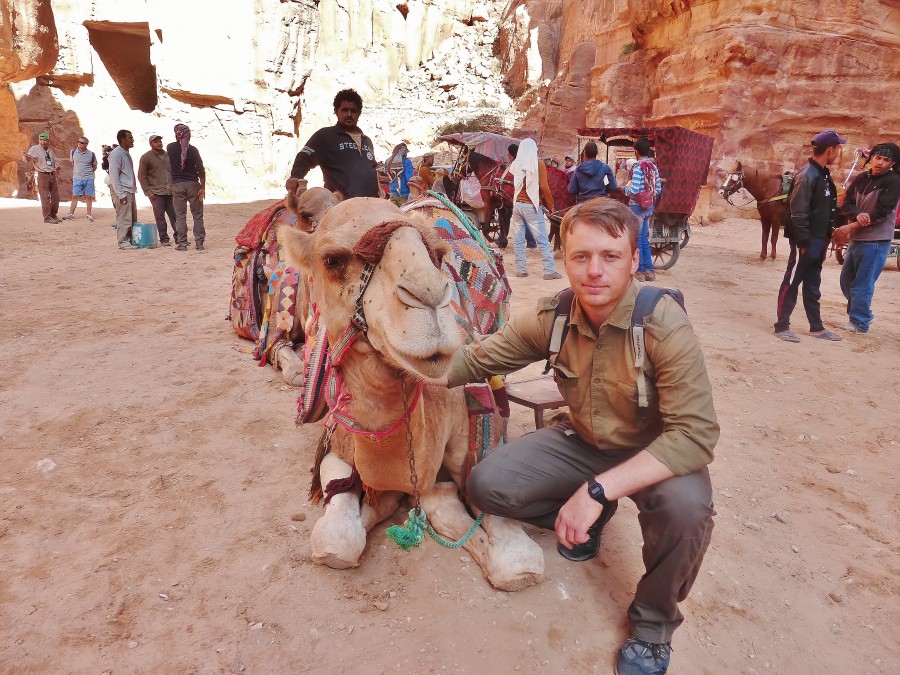
With a smiling camel in front of the Treasury. Petra, Jordan.
My impression of Wadi Musa
Wadi Musa is a tourist ghetto, just a few kilometers away from Petra, where I stayed at the Qasr Al-Bint hotel for only 5JD per night. I was very pleased, because although it was a single room, I lived alone, I had free tea and a hot shower. Because the sun heated the water in the roof tanks throughout the day. The only problem that didn’t let me sleep was a mentally sick rooster, which started his concert from 4 am and never stopped. My window was of course his favourite place. Once I threw a shoe at him but it didn’t help, because he came back and tossed his beak even louder. In the hotel I also met a traveller from Poland, with whom we tried to figure out, how to save 50 euros on the ticket to Petra, and get in for free. As it turned out later, our sneaky plan proved to be yet another, interesting adventure.
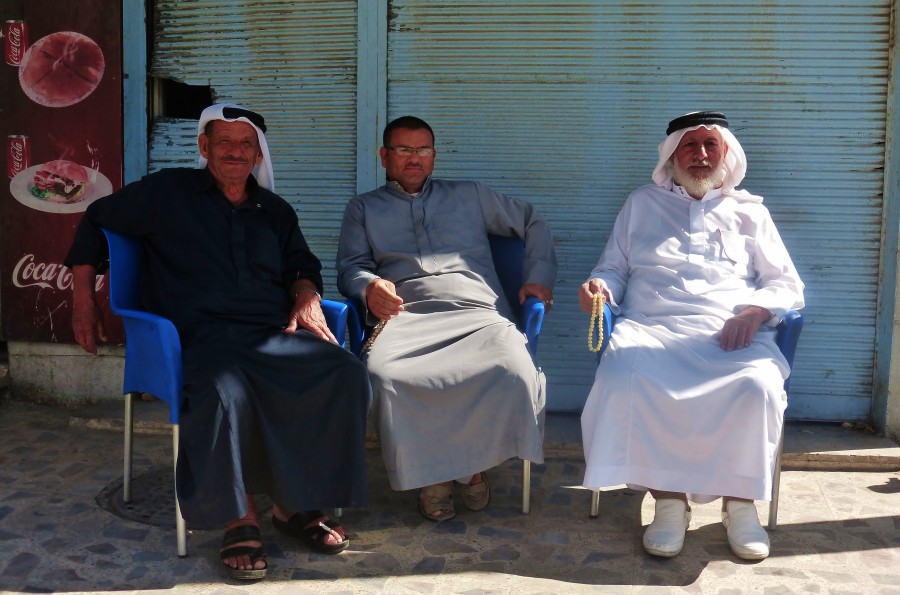
Jordan; men from Wadi Musa, near Petra.
The receptionist was exceptional too. He looked like he had not slept in a few days, but he was awake enough to remember that the price for the room depends on how the traveller could bargain. In Vietnam for example it was the same, because everyone in Halong Bay boarded the same boat, but everyone paid differently. In Wadi Musa a German man paid 40 euros, even though Arabs wanted 50 euros, the French paid 25 euros, and the Poles only 5 euros, because the Arabs have already learnt that from Poles it would be hard to squeeze more. That’s why first they asked me where I was from, which is by the way a tradition also in Tajikistan. The receptionist was nice once we made the deal, but lonely white women should be careful. I remember when one Arab gave me a computer and said to me: “Martin, you just sit over there, use the computer and do not interfere”. Then he gave a white woman some cheap necklace, and when she thanked him, he grabbed her by the neck and kissed her on the mouth so hard, that she stood petrified with her eyes were wide open. Then she looked at him in great astonishment, turned around on her heels and returned to the room. After that it was all right, Arabs did not chase her anymore, but this is yet another proof that White women should only travel in the company of a husband or a father.
In addition, whilst in Wadi Musa I had good lamb kebabs with onions, I did my laundry and had great bakhlava. Every evening I went to a pub for tea with a mint leaf, I talked to the local Arabs, and I was happy that I was in Jordan. I think that Wadi Musa is a very well organized small town, which main advantage is of course its close proximity to Petra, but also a relaxed atmosphere and desert views. The whole town offers many souvenirs from Petra, and there are many hotels for the poor – such as me, and for the rich tourists on organized trips. In Wadi Musa every Arab with a donkey is a potential guide. Travellers cannot get lost over there.
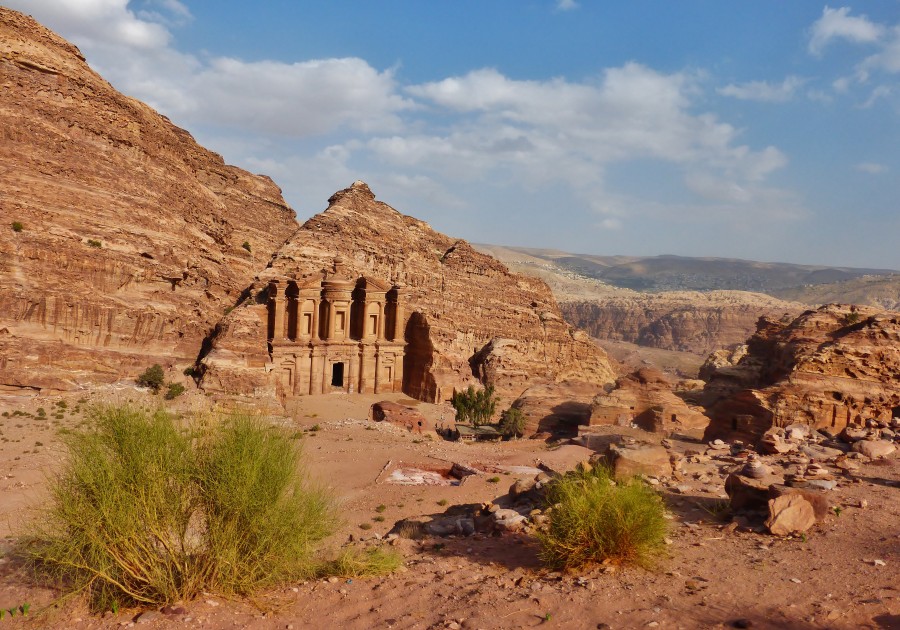
Al-Deir Monastery. Petra, Jordan.
The history of Petra
Before I go to the description of all the places which I saw in Petra, and before I tell my readers about my impressions of Petra, I think that first I should explain what Petra actually is. This will not be however a lecture about the history of culture and art, but only a way of introducing travellers to the subject of Petra, and my desire to interest them in this unique place. Petra (in Arabic البتراء, Al-Batrā) is an ancient city in southern Jordan, with enormous historical and archaeological value. Petra is located in a canyon in the desert, between mountains, on the slope of Al-Madbah, near the Arabah Valley, stretching from the Dead Sea to the Gulf of Aqaba. According to archaeologists, the territories of today’s Petra were already inhabited around 9000BC, and it was probably founded in the IV century BC, as the capital of the Nabatean Kingdom. The Nabataeans were nomadic Arabic tribes originating from the Arabian Peninsula. That ancient tribe constantly travelling through the Arabian sands in camel caravans, mainly traded spices and survived on animal husbandry. When they got to the southern Jordan and found strategically located canyons and defensive mountains in the area of today’s Petra, they decided to establish a capital there.The additional advantage was also its close proximity to trade routes, which together with the development of Petra became the main commercial centre in the region.
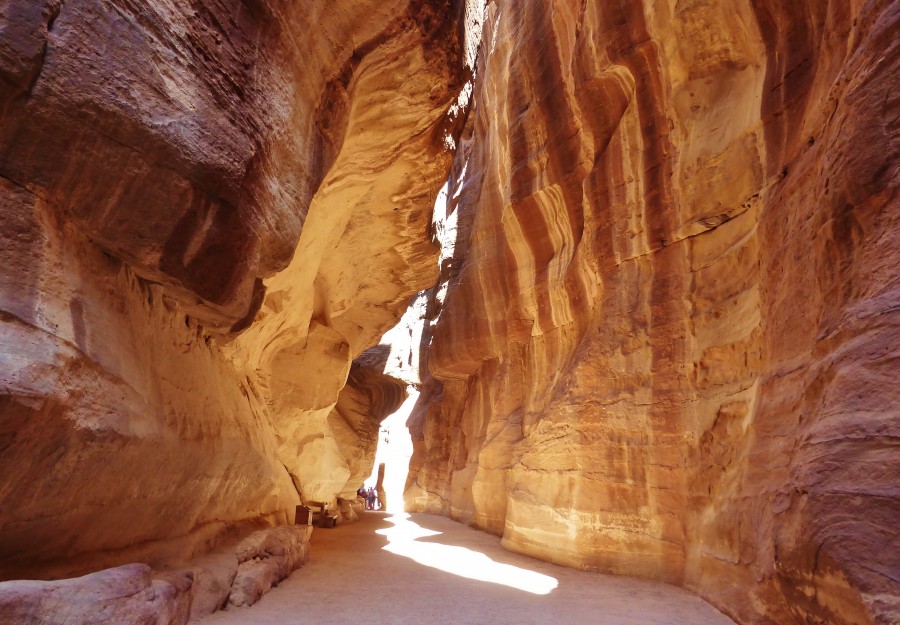
Siq Gorge. Petra, Jordan.
Surely Petra’s good times lasted about five centuries. In the first century BC, the entire Nabatean Kingdom was taken over by the Roman Empire, although its total independence was lost in 106. The Romans developed trade and expanded Petra (for their own benefit), which despite the dependence on Rome, pleased the Nabateans. On the other hand it was the beginning of their end, because after the emergence of permanent trade routes operating in favour of Rome, Petra lost its importance. Then, in 363 there was an earthquake that destroyed many objects, and further attempts to rebuild Petra were already a lost cause. In Byzantine times several churches were built there, and after the Muslim conquest, Petra became a city without any future, and apart from a few Arabian nomads nobody lived there anymore. As a result, in the second half of the fourth century, Petra became a forgotten place in the desert, and it was forgotten not only by the Europeans, but also by the Arabs.
Petra was rediscovered again in 1812 by a Swiss traveller and explorer Johann Ludwig Burckhardt. That magnificent, amazing place, famous for its rock architecture and water canyons was included in the UNESCO World Cultural Heritage List in 1985, and was named as: “one of the most valuable cultural properties of the human cultural heritage”. Petra was also included in the 7 New Wonders of the World, it became the symbol of Jordan, and in 2010 it was visited by 1 million tourists. Next to Angkor Wat in Cambodia, the Great Wall in China or Machu Pichu in Peru, also the Treasury of Pharaoh (in Arabic الخزنة, Al-Hazna) joined that honourable list.
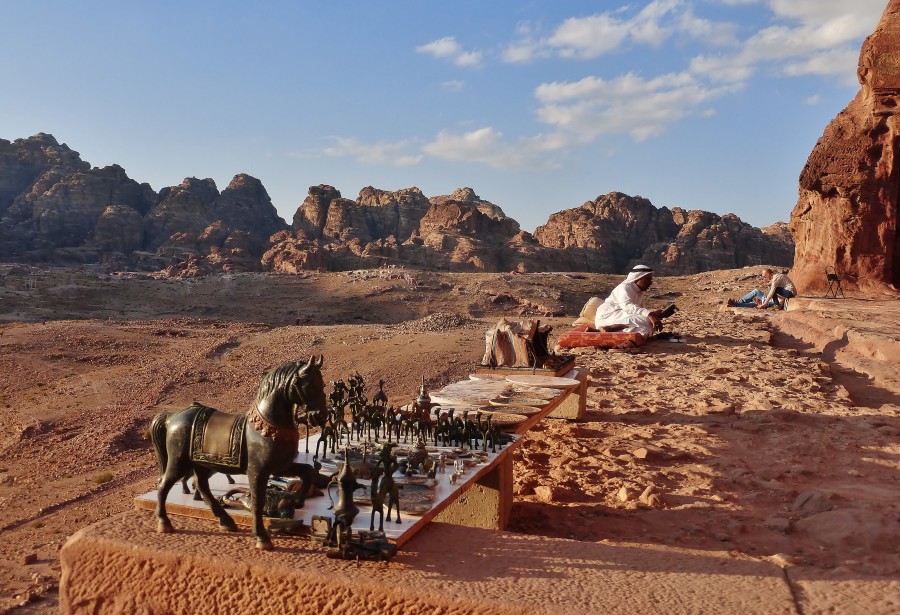
The landscape of Petra.
The astonishing thing is, that Arabs had Petra under their noses for centuries, but they were not able to realize its value, until the fearless White traveller and explorer gave the humanity the opportunity to experience what he discovered over 200 years ago. By the way, a similar situation was in Angkor Wat in Cambodia, because over there the Asians also had the ancient city in the jungle, on their door step, and they also could not realize its value; until the brave French naturalist and traveller Henri Mouhot discovered that ancient city in 1860.
(This paragraph is dedicate specifically to the tireless promoters of the “White Guilt”).
Way to Petra through the secret canyon
I got up at 6 in the morning and with my Polish friend we went to visit Petra. The problem was however, that the Arabs only paid 1JD for entry, while the members of our race had to pay 50JD for 1 day, 55JD for 2 days and 60JD for 3 days. These prices were in force in 2015 when I visited Petra, and that cost was so exaggerated that even the Jordanian Ministry of Tourism agreed to reduce the entry for Whites to 21JD per 1 day, but only from 2016. For that reason, we came up to the opinion that there was no point to overpay, if we could try to enter for free, to experience that interesting adventure. We therefore went to Petra through a narrow canyon, which turned out to be a unique experience. We both walked through remote and isolated areas. We had to be careful not to fall off the rocks, and sometimes we squeezed through very narrow gaps. Once I also had to jump from a 3m high rock to the distance, because I had water under me. I bounced as hard as I could, but I didn’t have a good run-up, and that’s why I fell into water to the level of my knees. (I have a video from that jump.) The climate however was very dry and hot, that’s why getting wet in Jordan is not a long-term problem.
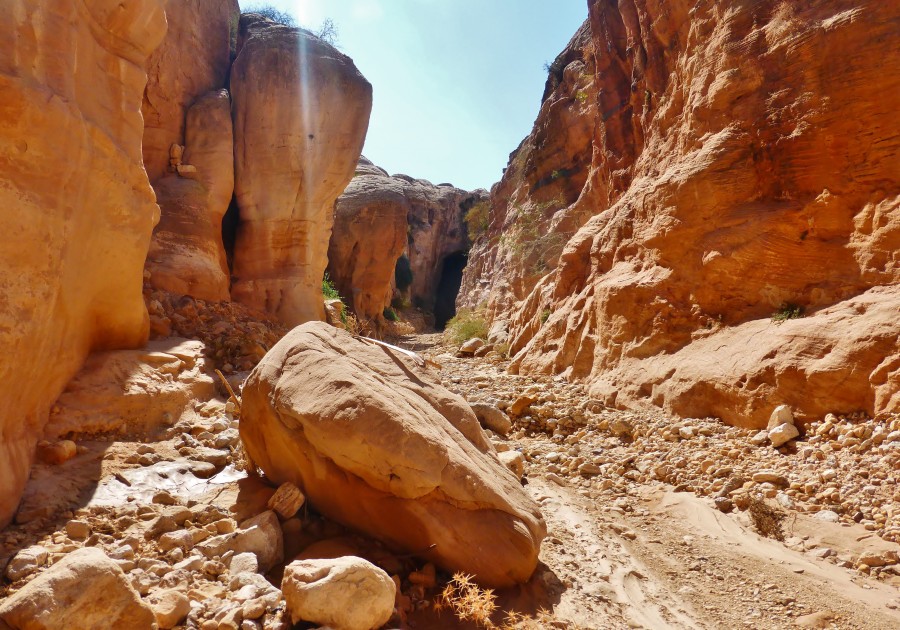
Jordan; a secret red canyon leading to Petra, through which I got to Petra for free.
We had maps and a plan with pictures of plants and rocks from the illegal path towards Petra through the canyon, because someone had already done it before us. From time to time someone takes a risk anyway, and I drew my inspiration from SneakIntoPetra.com, which is not available anymore. Despite the maps and photos, in a tiring, hot climate, we were afraid that we could get lost, even though the topography of the area was in line with what I saw inside the canyon. When we left the narrow path made of red rocks, we got to a more open space, and then to a rock tunnel. In that place we had to behave very carefully, because tourist police was patrolling the area just ahead of us. We also saw the booth, where the police waited with weapons and binoculars. I realized that since I knew about the secret free passage to Petra, the Arabs who were brought up in the desert knew it even better than me. For that reason I had to act quickly and decisively, and when I saw that the police turned around, I ran on the rocks unnoticed and joined quickly a group of paying tourists, which I left soon after. In that moment I knew that I won, because the ticket offices and the guards were about 1km behind me. I was sitting on the rocks, calmly looking at the police, and the police looked at me. Then I drank water and I talked to the police, so that my Polish travel companion could slip in for free too. I thought: “What an adventure, I was in Petra, but as if I wasn’t there – because I didn’t pay.”
The next day I also wanted to get into Petra, but I knew that I would have to show a ticket for 55 euros, and on the other hand I didn’t want to crawl through the canyon, nor jump into the water again. After the first day I was very tired, and that’s why I felt that I worked off my 55 euros. On the second day, I also planned to enter for free, but this time I wanted to enter without any effort, and I realized that in order to achieve my goal, I had to be even more brazen than ever before. On my second day I went to Petra using the entry for normal tourists, and when they asked me for a ticket, I started looking for it and I was pretending to be very surprised that I didn’t have it. When they started to direct me to the exit, I said that I could prove that I was in Petra yesterday because I had my photos. At that time, the guards and policemen looked at my photos, but their argument was that I could have taken them two years ago. Fortunately for me, I predicted that question, and that’s why I set the camera in such a way, that yesterday’s date would always appear next to photo. They commented: “yes, you don’t lie, you were here yesterday.” I couldn’t hide the fact that I indeed saw Petra a day before, but I didn’t want to continue that story. That way I started my second free day in Petra.
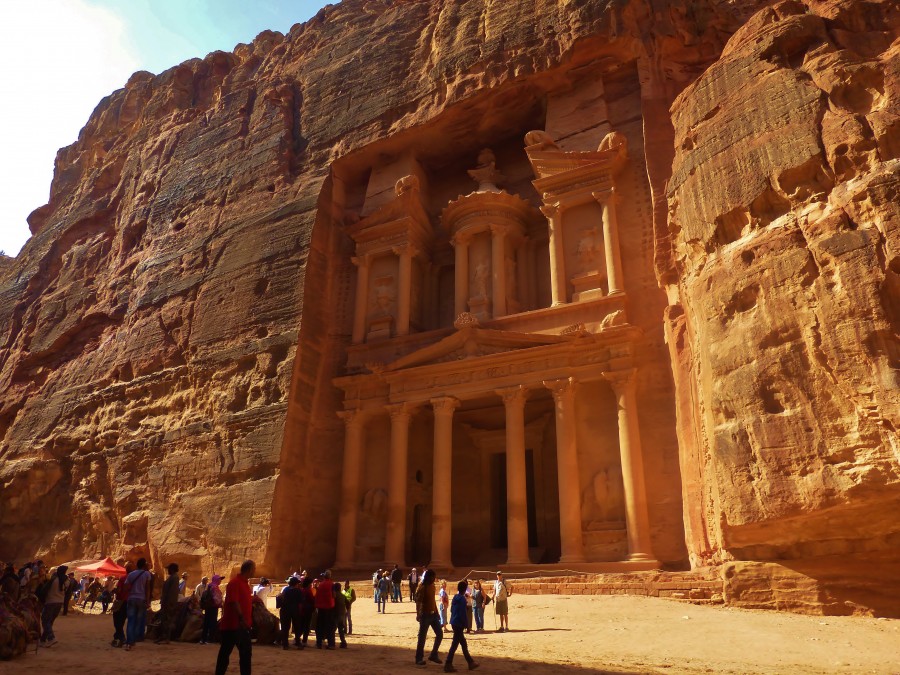
Treasury. Petra, Jordan.
Petra – my two days
From what I have noticed, Petra is known to the Europeans mainly from the movie “Indiana Jones and the Last Crusade”, where the main character gets on a horse in front of the Pharaoh Treasury carved in a rock, and departs with music playing in the background. However, the Archaeological Park of Petra is not just one object, but an ancient city, which covers an area of 264 square kilometers. In its area there are red canyons, temples carved in rocks on the surface of the earth and in the mountains. There is also a theatre, a Roman street, water channels forged in rocks, living rooms carved in the mountains and even an altar intended for ritual sacrifices. Petra is a city of natural beauty and rock art, which is over 1500 years old, and which requires efforts and learning from travellers.
Petra can be visited in several ways. I like to get everywhere and devote more time to visiting places and interacting with local people. I like to devote to each object the optimal time to understand it better, and drink tea with Arabs in the desert, and bargain with them for another silk scarf, for my pure blooded Slavic women. Sometimes I also talked about politics because the Bedouins were curious about how it is in Europe. They were also honest about their opinion of Europeans, which was not good; but especially when it came to our women. In summary, I would like to point out that Petra is a complex of very interesting historical objects that deserve optimal time. However, people selling souvenirs are also interesting because they let tourists to better understand this place. Many European and American snobs think that poor people are stupid, but according to me the opinions of poor Arabs brewing tea on a slow fire or offering donkey rides are very important, because without them I wouldn’t have fully valuable travel memories. In addition I advise to hire a guide, because that way we could learn more, and our euros and pounds would go to those who need it most. This is my way, and because I like “luxury” I got on a donkey.
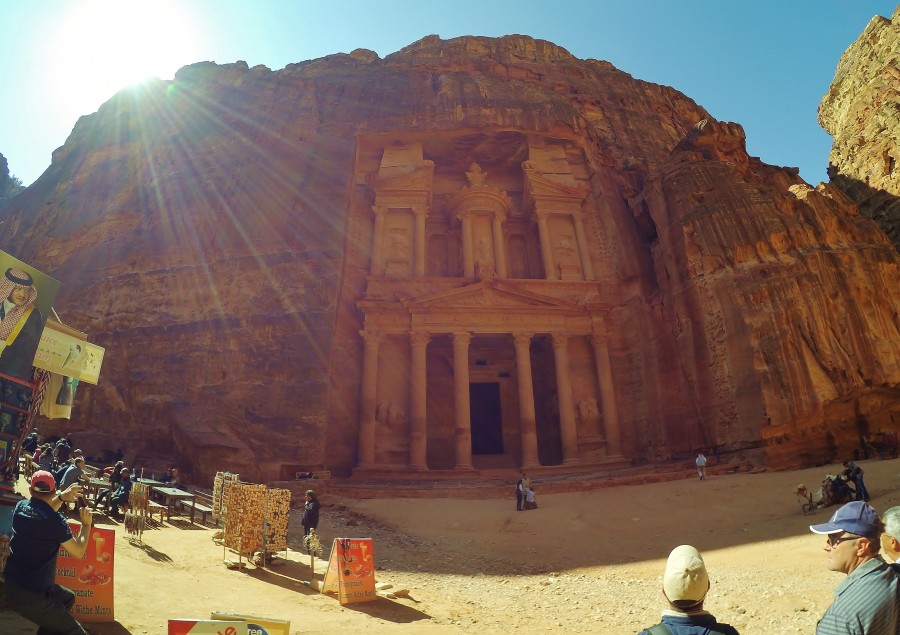
The Treasury, (لخزنة, Al-Khazneh). Petra, Jordan. Please pay attention to the strong sun and do not forget and the cap and water.
The second way of exploring Petra is on organized trips, where tourists have little contact with people, but also not enough time for monuments. I saw such a trip in Petra, and unfortunately it was limited in time, because tourists were constantly rushed by a guide like a herd of cows. I advise against that way. I also saw tourists in Petra completely out of touch with reality, because they travelled by horse-drawn carts covered with materials, and they didn’t see anything around them. Sometimes, they just stopped at the main monuments to take a few pictures, without getting off the horse cart. What’s the point? I don’t know and I was not able to ask because they didn’t have time to answer. Therefore, I would like my readers to answer the question, which way of visiting Petra is the best for them.
The Siq gorge
I started visiting Petra from the eastern side, with a 1.2km walk through the Siq Gorge, which leads directly to the Treasury of Pharaoh. The Siq Gorge is a picturesque passage between red sandstone rocks, of dramatic shapes, of different widths and with magnificent rock formations. The first thing that occurred to me was of course, the vision of the gorge being shaped by a huge river, also called water erosion, but the Siq gorge was created by tectonic forces that caused the sandstone mountain to split into a deep, narrow path. My critics, who consider themselves to be geological experts, may ask why the rocks and all the edges are smooth, to which I would reply that the Siq gorge was made by cracking rocks, but then it was then polished with water. This spectacular red gorge is usually 3m wide, although sometimes it is wider, and sometimes it is so narrow that if a beautiful naked woman was sunbathing in this place, she could touch both sides of the rock with her fingers and toes. Inside the Siq gorge one should also pay attention to the bas-reliefs, underground chambers and channels carved into the rocks, which were intended to bring precious water to all parts of the ancient Petra.
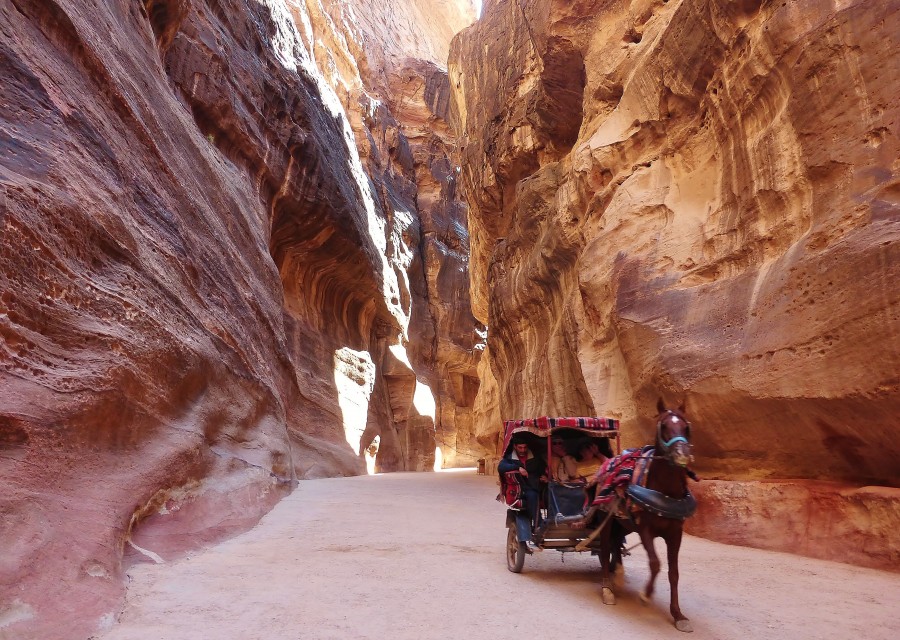
Horse-drawn carriage. Siq Gorge. Petra, Jordan.
The Treasury of Pharaoh
At the end of the gorge the road began to be very narrow, and before me appeared The Treasury (لخزنة, Al-Khazneh). It is he symbol of Petra and the symbol of Jordan. I found myself on a sandy square surrounded by mountains, where Arabs stood with camels and donkeys, and where there were shops under tents and posters with the King of Jordan. Of course, the most important in this place is the Treasury, but I was not in a hurry. First I walked around the square, I stroked camels and donkeys, I bought water and then I exchanged a few words with a beautiful Ukrainian woman who was traveling with her husband. Well, after that there was nothing else to do, but simply pay attention to the main object. Al-Khazneh is the most famous and the most decorated building of the ancient Petra, which was built of red sandstone in the first century, in the times of the Nabatean ruler named Aretas IV Filopatris. This building was in fact not a treasury but a mausoleum and the crypt of Aretas IV. The legend however tells a story, that in the stone urn inside the building, on the second level, the ancient king hid his wealth.
This is where the name “Treasury” comes from. A group of Bedouins who were searching for a quick profit in the 20th century found that out, when they shot the urn with bullets, believing that gold coins would fall out of it. The urn decorated with patterns is only a solid rock, and the bullets have been there until this day. Another legend says that Al-Khazneh was the treasury of Pharaoh in the days of Moses, but whatever the imagination, it is a grave crypt made of solid sandstone, with a very impressive facade carved in the rock. On the wall there are also many bas-reliefs symbolizing life after death, and thus for example, we can see eagles there, whose task was to transfer the souls of the deceased to the other world. In addition to them, there are also columns carved in the rocks and a spectacular roof.
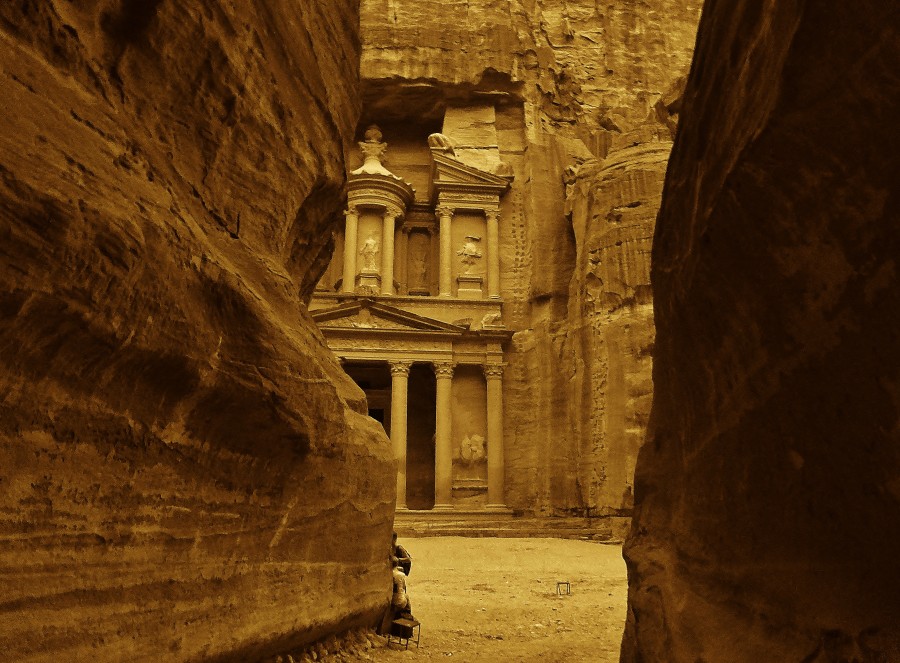
Treasury seen from the Siq Gorge. Petra, Jordan.
Al-Khazneh is known mainly from the third film about the archaeologist and a traveller Indiana Jones, but this special and unique object is so widely recognized throughout the world, that it also appeared in the music video of the band: “The Sisters of Mercy – Dominion”, the film Transformers (2009), and many other films and series. Petra, but especially the Treasury with camels posing to photos is a world heritage site. For that reason I advise to respect it and not to rub the rocks or lean against them, and not to wipe your hands. Because tourists lean against the pillars and walls of Al-Khanzeh, its walls have narrowed by 4cm in 10 years. Even resting hands on it causes the formation of stearic acid, which explains the white spots that appeared on the site. In addition, Petra is in a dry, hot climate and sandstone is sensitive to moisture, what means that a million tourists annually who breathe in this place certainly do not help. Let’s take care of this site for the future generations.
I want to add that the Treasury can also be viewed from the rock above, but how to get there I will tell later. It is also very popular to watch the Treasury at night by candlelights.
Fasade Street
When I left the square where Al-Khazneh was located, I went through another gorge, usually referred to as Outer Siq, until I reached a large open space called the Fasade Street. It is a huge, wide area, with about 40 tombs and mausoleums in many sizes and at different heights, but architecturally referring to the Treasury. I spent time there walking on rocky roads located higher above the ground, and I reached rooms of many shapes and patterns on the walls. At first I thought that these were residential homes carved in the mountains, as it is in Hasankeyf in eastern Turkey, or in Goris in Armenia, or in Kandovan in Iran. But in Petra, the facades were not houses but tombs, and those which were the smallest, were intended for the poorest. My guess is that in the Nabatean culture, death and preparation for death itself could have been as important as it was in ancient Egypt. In some tombs there was only mud and dust, while other ones had straight, naturally multi-coloured walls. It was also amazing that without the use of advanced tools, even thousands of years ago the Nabataeans were able to carve even walls in the mountains.
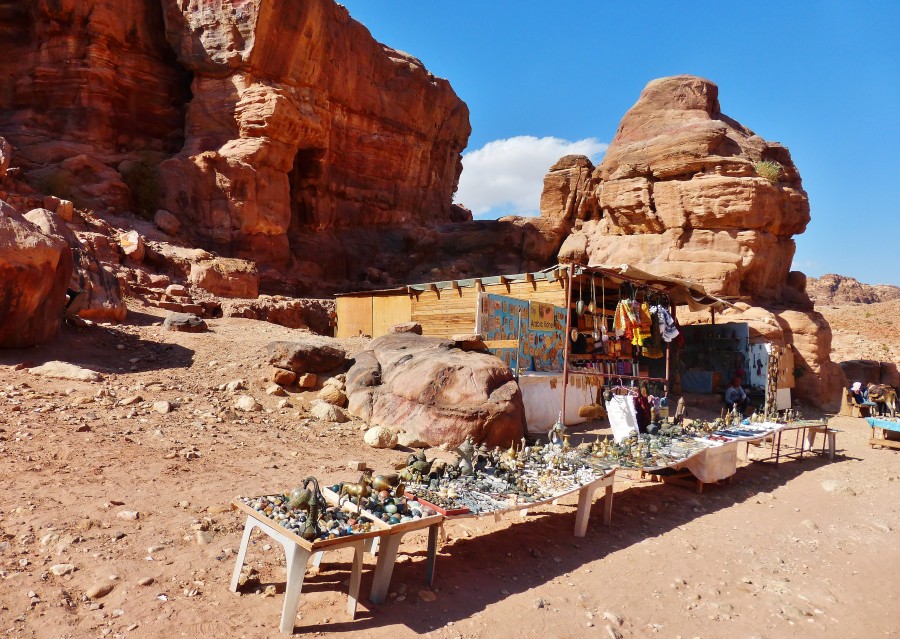
Market stall on Fasad Street. Petra, Jordan.
Many tourists rush through the facade streets but in my opinion it’s a mistake. In the Fasade Street tourists can see Arabs on camels and donkeys, and Bedouins selling souvenirs and making tea on fire. In addition, the exploration of tombs is easy and gives pleasure to people who love to explore. Many tourists bypass the Facade Street, because a little further away there is a Theater made of solid rocks. Its shape resembles Roman theaters, but one should not be fooled, because the Theater was built by Nabataeans about 2,000 years ago. It was built to accommodate 3000 spectators in 45 rows. However, when the Romans entered Petra in 106, they immediately enlarged it to accommodate 8,500 spectators, or about 30% of Petra’s ancient population. Therefore the theater was of great importance in the Nabatean culture, if they made that great effort and carved in iron-hard rocks to complete such an ambitious project. At the back of the Theater there are more tombs carved in the rocks.
Royal Tombs
Another object carved in the rocks are the Royal Tombs. It looks like a palace on a wall of red sandstone. Of the many, the one that should be certainly mention is the Urn Tomb, which is set higher up on the mountain wall, and according to the archaeologists, it is the tomb of the Nabatean king Malchus II, who died in the year 70. The tomb also has magnificent columns, three burial chambers and arches carved in the rocks when it was transformed into a church. Next to it, there is the beautifully coloured Silk Tomb, and then more damaged but similar to the treasury of Al-Kahzneh, the Corinthian Tomb. The Palace Tomb is also very impressive, as its front wall has 18 columns and it looks like a palace. It has also a large chamber inside, and outside there is a courtyard, most probably intended for funeral ceremonies. From that place there is a good view of the ancient city, because it is located a few meters above the ground. I believe that the tombs were also of great religious and cultural importance for the Nabataeans, because they were given a great importance during their construction. A bit further there is the Tomb of Sextius Florentius, who was the Roman governor of Arabia. There are 5 graves inside, and outside you one drink tea with Bedouins.
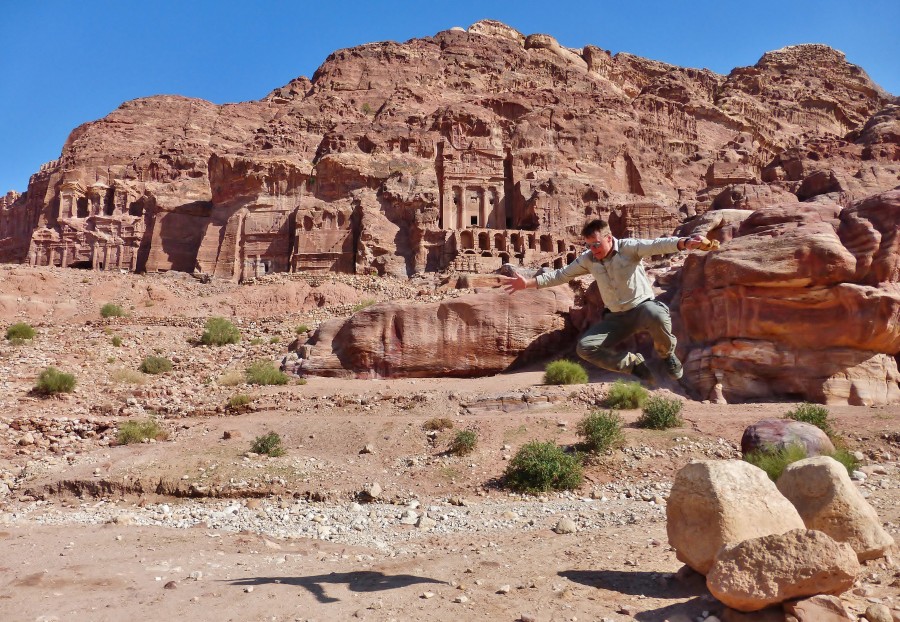
Royal Tombs seen from the Fasade Street. Petra, Jordan. In the picture: author of Kompas Travel during the flight.
Colonnaded street
Then, in the very center of ancient Petra, there is Colonnaded Street, also referred to by the local Bedouins as the Roman Street. The street was built by the Nabataeans, but as soon as the Romans took over Petra in 106, they immediately rebuilt the Column Street to the Roman standards. (By the way, exactly at the same time and in the same style, Romans built a Column Street in Jerash). Colonnaded Street in the ancient city of Petra was used until the 6th century as a commercial center, and although it is now ruined, and even though that apart from a stone road and several columns nothing has remained, centuries ago there were 1 and 2 storey buildings that served as shops. Colonnaded Street starts with the Nymphaeum fountain, built in the second century. Further, among the stone rows there is a shadowy 450-year-old pistachio tree, followed by the ruins of Fharaoh’s Daughter Palace (Qasr Al-Bint). To this day, the stairs and the massive walls of the temple have been preserved, but not the roof.
This building was built by the Nabataeans in the year 30 for worshiping the Nabatean gods, but it was later adapted by the Romans as a pagan temple. Given that this palace is already 2000 years old, I think it has survived in a good enough state to imagine what it used to be like. In the years of splendour it was one of the holiest sites of the Nabateans and it was 23 m high. The name itself – the Palace or Temple of the Daughter of Pharaoh is a Bedouin‘s invention, because the temple had nothing to do with a Pharaoh, but only with the Nabataeans gods. I suspect that the word “pharaoh” appears in Petra several times as a sign of greatness and wealth, competing with ancient Egypt. Colonnaded Street ends with the Passage of Temenos, built in the second century. There used to be a huge wooden door opening the shopping street, but only massive columns remained to this day. Next to it there are also ruins of the Nabatean bathhouse, but they didn’t survive the burden of time.
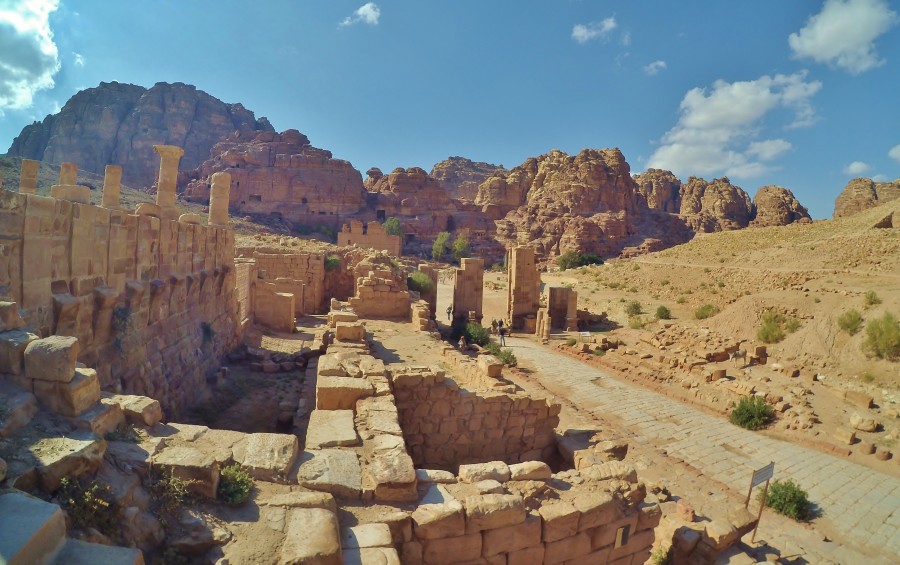
Colonnaded Street. Petra, Jordan.
Colonnaded Street is always busy and tourists can always meet Bedouins and see other tourists riding camels. It is possible to haggle with them, and if someone has style, he can visit the great area of ancient Petra in a glorious way, that is on a camel. There are other options too, such as horseback riding and climbing to the higher parts of Petra on a donkey. I recommend!
Great Temple
On the south side of Colonnaded Street, in front of the hill, there is the Great Temple, discovered in 1921. For approximately 1900 years this huge building was covered with Arabian sands, but in 1993 restoration works began. To this day, it is not known whether the “Great Temple” was just a temple or if it was so huge because it also served as the Nabatean Parliament. This guess may suggest a semi-circular hall, as we know it from the Roman senate. It is also unclear whether the roof was empty in the middle or whether the roofing was covered only by external walls. Inside, we can still see attractive stone arches, sculptures depicting elephants, and remains of paintings on the walls, which despite long years have preserved their clarity. In addition, recent archaeological discoveries have provided evidence that there was also a public pool and a garden next to the building, not a market square as previously thought. I think that this discovery should be very important to us, because thanks to it, we are able to say more about the daily life of the Nabateans. In the years of splendour the Great Temple was 18 meters high, and it was located on a square of 40m x 28m.
In addition to the places I have described, there are several other interesting objects in Petra. There are chambers in the rocks, bas-reliefs and temples. Petra is a great example of how the ancient civilization was able to transform bare rocks into the art of building, and thus leave this educational material for the future generations. Thanks to the hard work and ingenuity of the Arab nomads, and thanks to the improvements made by the Roman Empire, beautiful Petra was created. I am also happy that Petra was discovered for the modern world by White European adventurers.
There is still however a lot to be discovered in Petra, and this is what I am asking for the future travellers.
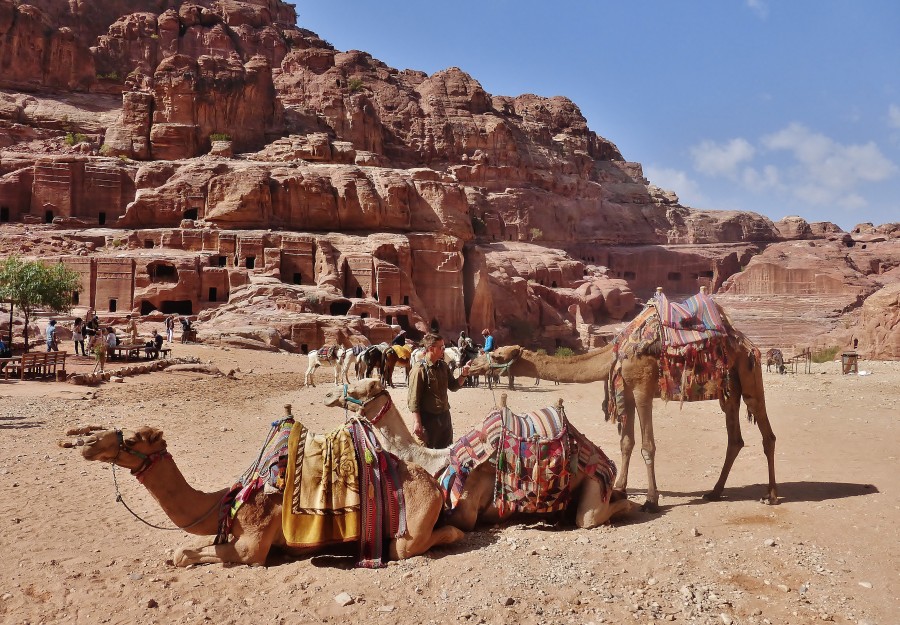
With camels during a desert expedition. Petra, Jordan.
Climbing to attractive places in the ancient city of Petra
As I mentioned earlier, I spent two days in ancient Petra, and some places were so amazing and offered such picturesque views of the desert and mountains, that I decided to see them twice. Some places I climbed on foot, and others on a donkey, and I spent long hours looking at certain places. During my first day I learned about Petra in general, while on the second day I chose my favorite places and I dedicated them more time. The second day was also easier for me, because I didn’t have to cross the difficult canyon. One day is definitely not enough, that’s why I recommend two or three days to embrace Petra with your mind and remember it well.
Travellers who know Petra just from the perspective of one temple shown in the Indiana Jones, do not understand that Petra is primarily a mountain expedition, and therefore to reach some very important and dramatic places, one must put in a lot of effort. Especially in the hot climate of Jordan it is even more tiresome. The most ambitious explorers should hire a guide with a donkey or a horse, and take water supplies. Less frequently used trails are unmarked and depopulated, that’s why I advise to have an expedition plan, taking into account your abilities.
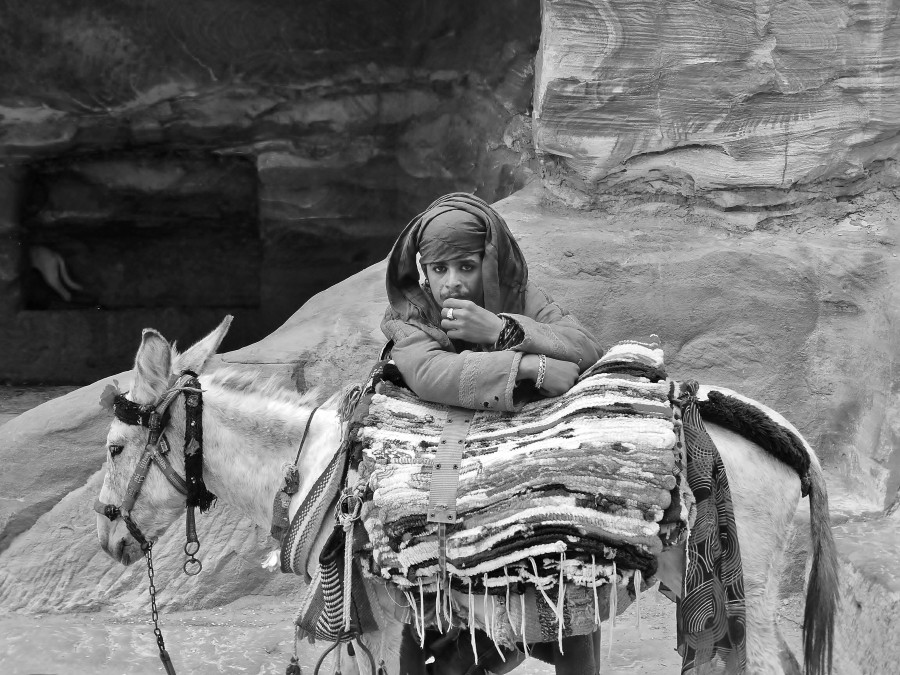
Bedouin with a donkey. Petra, Jordan.
The Highest Place of Sacrifice
Just behind the Theater there are stairs to the top, leading to the Highest Place of Sacrifice. It’s a pleasant, about 30-40 minute climb on stone stairs, including time for taking photos and tea with Bedouins. With proper distribution of strenght this climb does not require much effort, but it is better to start early in the morning, because around 12 noon the Jordanian sun starts baking without mercy. However, the Highest Place of Sacrifice is not only the place at the top, as the climb itself is also a great adventure. Red rock formations, tombs carved in rocks and a fountain in the shape of a lion are the reasons to pay attention. There are also two statues of Nabatean deities. The march up the Bedouin trail Jebal El-Kubtha begins with a large stone gate, where tourists can see stone stairs and corridors carved by Nabateans, and which offer dramatic views.
At the top of the Highest Place of Sacrifice there is a 15m x 6m altar, engraved in the rocks, which in the days of the Nabateans served mainly for the sacrifice of animals to the Nabatean deities. The Nabataeans worshiped, among other things, a deity named Dushara and Al-Uzza, who were also given human sacrifices in the pre-Muslim Arabia. According to the philosopher Phorpyrius, who lived in the second century, once a year they cut a boy’s throat. The same happened in the Nabatean city of Dunat, 300 km from Petra. Taking into account that religious custom, I think that people were also sacrificed, to satisfy the blood first of the primitive deites. The same practice also took place in the Inca and the Maya kingdoms, and also in the High Place of Sacrifice, at the top of the temples, under the sky. The Nabatean religion also allowed the corpses of the deceased to be displayed, which was for also practiced by the Zaraostrian Persians. I am writing about this, because tourists who visit Petra can see rocky landscapes and a desert, but Petra was also built on the blood of defenseless people. The Nabatean religious ceremonies were blood chilling experiences.
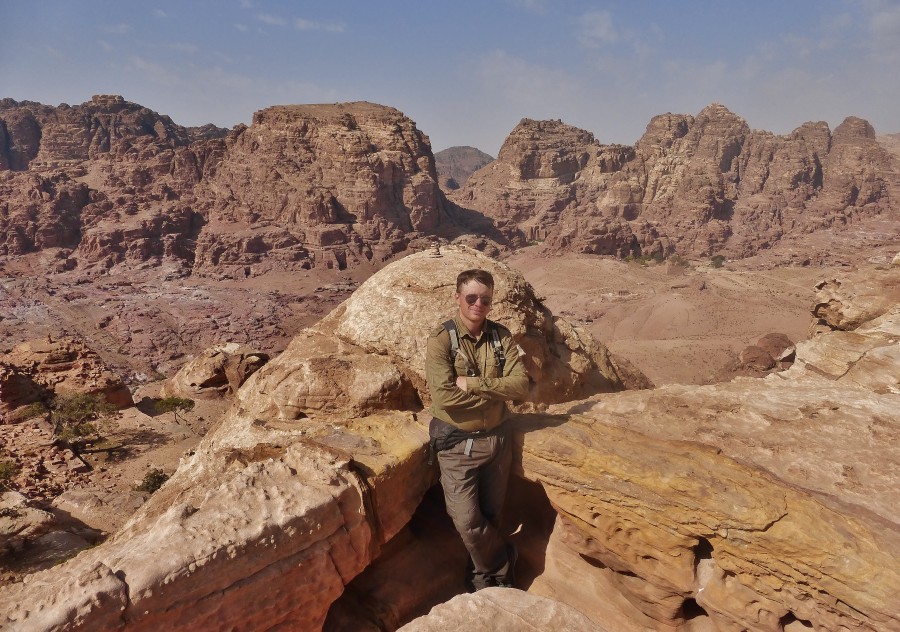
Martin Malik at the Highest Place of Sacrifice. Petra, Jordan.
From above there are of course great views of Petra, including the Theater, Colonnaded Street and many tombs. On the way back I chose the western route through Wadi Farasa. That road is more interesting than the previous one, because it gave me an opportunity to see more interesting objects. First, I saw a lion-shaped bas-relief with a water hole in its mouth. Then I saw a small cave called the Garden Tomb, located in a quiet place, and with a tree in front of the entrance. Then there was the Tomb of the Roman Soldier (as per the sculpture at the front door), and next to it there was also a cave with columns and urns, called the Garden Triclinium. Then I saw the Tomb of the Renaissance, with two columns and a bow carved in the rock. It was impressive. Then I went back to the Place of Sacrifice, and I went down where I started my climb. Tourists with a guide could see a lot more and continue the climb to Qasr Al-Bint, and even to the Monastery.
Monastery (Al-Deir)
A climb to the famous Monastery (Al-Deir) gave me enormous pleasure, but also a few moments of reflection on art and history. Stone stairs leading to the Monastery begin near the Nabatean Museum, and climbing the winding road over 800 stairs took me about an hour. On the way I talked to the Bedouins selling souvenirs, and I stopped on the slopes of the mountains to admire the views. The monastery itself turned out to be such a special place for me, that the next day I climbed it again, but this time on a donkey. The Al-Deir Monastery was built in the 3rd century BC, as a tomb for the Nabatean ruler, probably for Obodas I. The building was built in the same style as the famous Treasury, but Al-Deir is larger because it is 50m wide and 45m high. Besides, in order for the monastery to be built, first the Nabataeans had to carve back the mountain by many meters, using primitive tools. The door itself is 8m high, and the chamber inside the tomb has dimensions of 11.5 x 10m. Inside there are crosses on the walls, which are proof that the Monastery served as a church in Byzantine times.
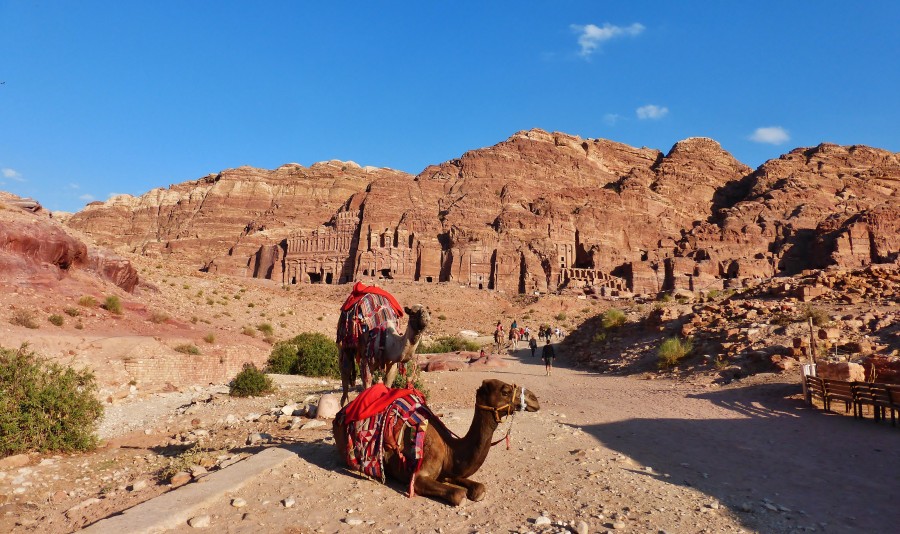
Royal Tombs and camels in the foreground. Petra, Jordan.
On the right side from the stairs, there is a road uphill through which it is possible to climb to the top of the tomb, although when I was there in 2015, climbing was already prohibited. On one hand it is a way to protect Al-Deir, but on the other this prohibition takes away beautiful experiences, such as details of carved rocks and a picturesque view of the vast gorges of Wadi Araba. In front of the Monastery there is even square, which in the Nabatean times was used for religious rites, but now it is a view point and a meeting place for camel riders offering trips to tourists.
There are also very attractive rock formations in front of the square, which provide opportunities for taking photos, and a very expensive restaurant under a tent. When I saw the Monastery I went up for a walk, passing through red sand stones of various shapes. After that I rested on a cliff overlooking the landscape of Wadi Araba. Sometimes I also saw donkeys, then more tents and Bedouins sitting by their fires. The most however, I enjoyed picturesque views and slow sunset over the desert. I could spend hours around the Monastery, because apart from the tomb itself, the surroundings of Arabia are also exceptionally beautiful.
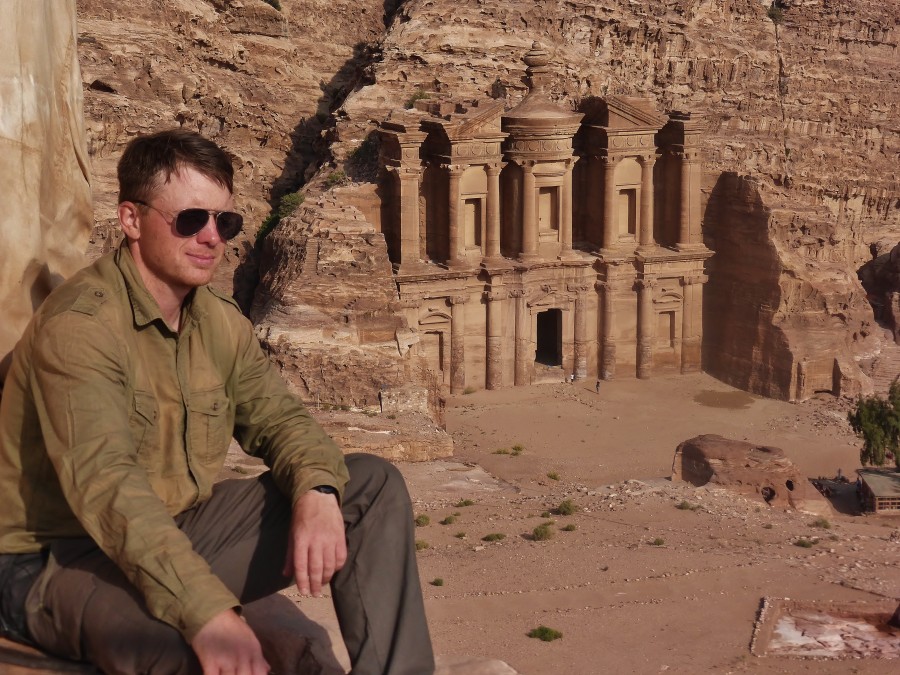
Al-Deir Monastery seen from a distance. Petra, Jordan.
Little Petra (Siq Al-Barid)
More ambitious travellers, and also those who have the strength and reserves of water, can continue their mountain expedition through the red mountains. About 6 km from the Monastery, there is Little Petra (Siq Al-Barid). It’s a series of canyons and winding passages between the mountains, where in addition there is one more, but a smaller tomb carved in the mountains. Climbing from the Monastery should take about 2.5h-3h. I advise to take a guide with a donkey from the desert level, near the Nabatean museum. I also advise to explain that the expedition must take place to the Monastery, and then after a 1h-2h stop-over, continue further to the Little Petra and back. Alternatively, one can ask for a guide, or for directions in a tent near Al-Deir.
Climbing for the views of Treasury (Al-Khazneh)
My last trip was climbing to the top above the Treasury. I organized that trek late in the evening, that’s why I came back in the dark. Even then it was very interesting, because on the way I saw interesting rock formations in variety of red colours. I walked on rock stairs, even though not all of them were in good condition. In the beginning I would like to say, that although for a person in an average shape it shouldn’t be such a great effort to get to the top, under the Jordanian sun it is easy to get tired and it is also possible to get lost. Luckily, on the way there are the “best view” signs, but even so I warn to not to cut corners and stick to the trail. Climbing to the top takes about 1.5 hours, but to some it could take up to 2 hours. It took me 45 minutes to get to the top, because it was getting dark. When I reached the top, I saw a Bedouin tent and I sat on the cliff to look at the Treasury (Al-Khazneh) from 200 meters above the ground. I consider this climb as a mandatory part of exploring Petra, because the experience associated with this view is really important.
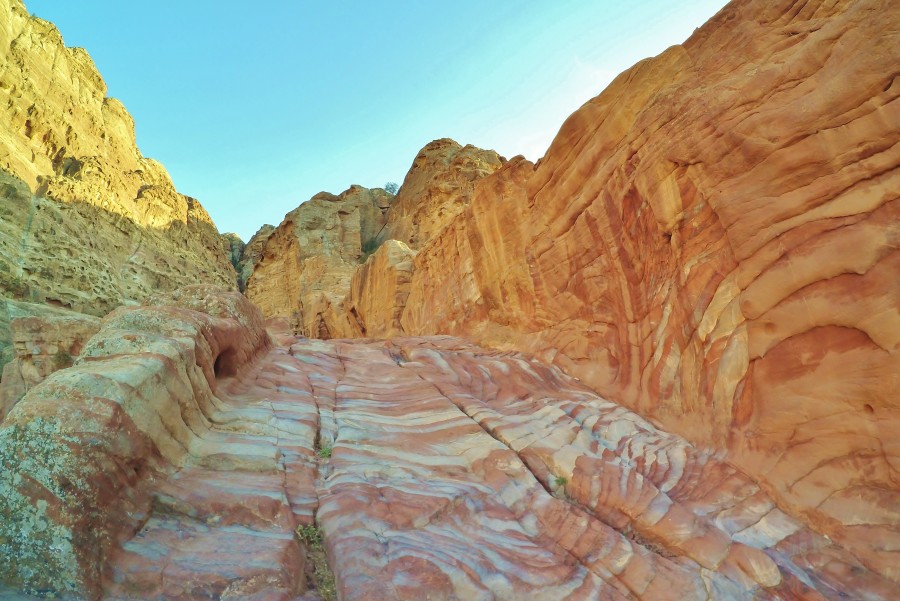
Red stairs carved out of the rocks, leading to the viewpoint of the Treasury. Petra, Jordan.
Help for the local Bedouins
I suggest Whites travelling in a group to give 10JD-20JD to an Arab boy who would happily take Europeans to the top. This way they could learn interesting things, they wouldn’t get lost, and they would notice “little treasures” along the way, such as for example small tombs in the rocks farther from the trail. Besides, It is a good way for us to help Arab families in their own countries, because the mass immigration of Arabs to Europe will not improve their countries at all, but may destroy our way of life. I support this kind of help, because I believe that different civilizations should help each other, but with mutual respect not only to foreign cultures, but also to their own.
These are the most interesting, and in my opinion also obligatory places in Petra, which must be seen and which deserve more time to reflect on. Petra is a mountain expedition of many rock treasures, meetings with Bedouins and getting to know their interesting way of life. I also think that even though the planned 3 days to see Petra are sufficient, travellers who are more ambitious and want to explore this huge area further, 3 days may not be enough. In that case, I advise explorers to bring tents on the third day and spend a night in an isolated place. I also advise to prepare money for guides, who would wish to undertake a trip to the further areas. White people often think that they are the smartest because they have maps and GPSs, but in this case Bedouins know better. I say this to let explorers know, that they can get lost on distant routes in Petra, and nobody wants to go astray in the desert without water.
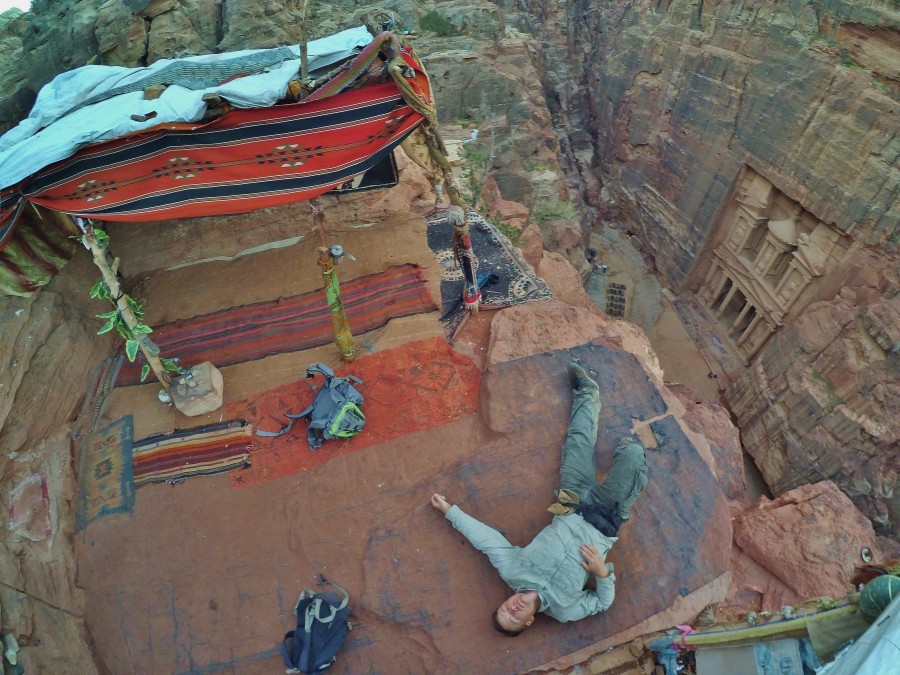
Treasury seen from above. Petra, Jordan.
“The Bedouin’s wife”
Whilst exploring Petra, travellers would surely come across a widely advertised book, titled the “Bedouin’s wife”. It is a true story written by a European woman from New Zealand, Margeurite van Geldermalsen, who was so delighted with Petra, that she lost her mind. She betrayed her White race and her culture, and she decided to live in a desert cave and give birth to Arab children. To Bedouins their culture is extremely important, and not only the Islamic culture but also the very specific Bedouin culture. It is based on attachment to the desert, living in tents, making tea on the camp fire and breeding animals. The Bedouin culture is not for sale, even though they could go to Europe to make more money, but they still live in their desert and continue the culture of their ancestors. In Jordan Bedouins are considered to be of the purest Arab blood, who have a very conservative culture; different than in such cities like Amman or Aqaba. (More about the culture of Jordan, and separately about the Bedouin culture I wrote on the page dedicated to the country: Jordan).
However, to a White woman her culture and her race didn’t have any value. For that reason she decided to deny her culture and become someone who she would never become. Pinocchio thought that he was a real boy, and the White woman thought that she was a Bedouin, because she took off her panties in the desert. Bedouins on the other hand are clever people, because they turned the whoredom of the White woman into a great business; often with the satisfaction of degenerate White tourists, to whom betrayal of their race and betrayal of their culture seems to be something attractive. I cannot blame the Bedouins however, and I can’t hate a man who ate an apple, because it fell on his head, when he stood under the apple tree. Let this paragraph be a warning to the traitors of the white race with a low level of self-value.
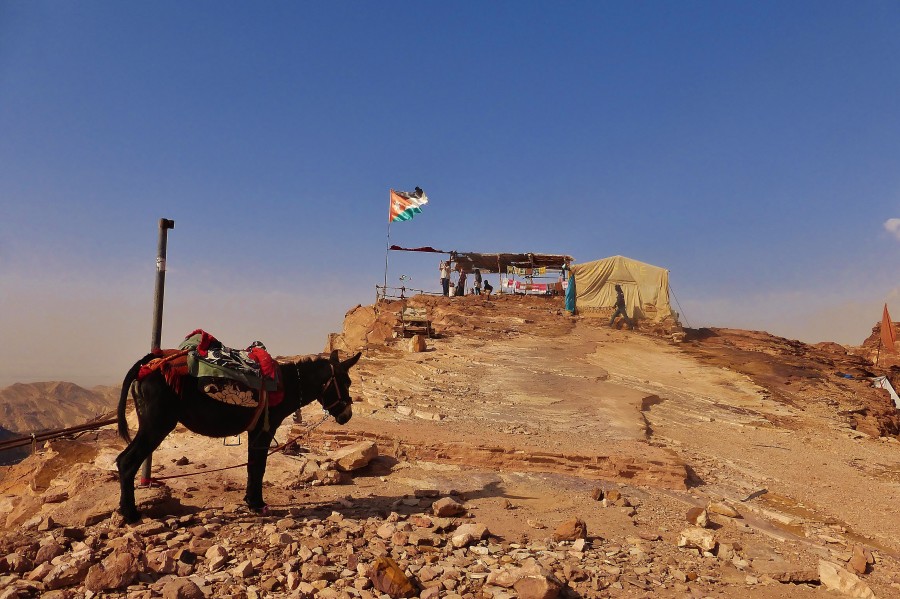
Donkey at the background of the flag of Jordan. Petra, Jordan.
Let’s remember, that Jordan is not just Petra. The whole of Jordan is very attractive to tourists, because it has many historical places and picturesque landscapes.


































